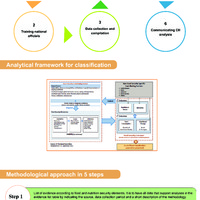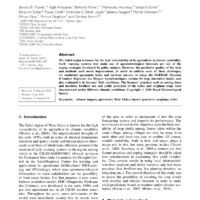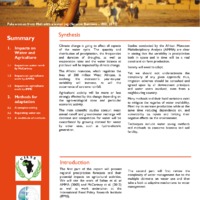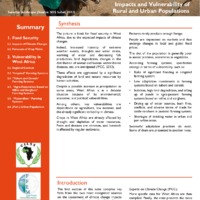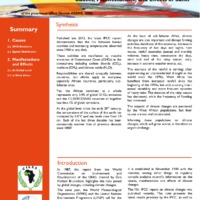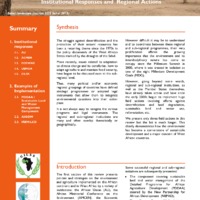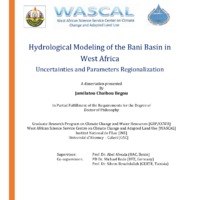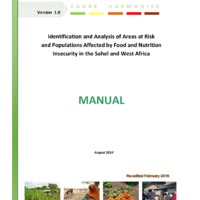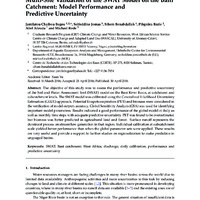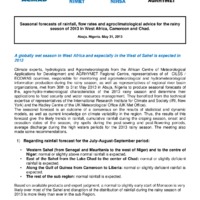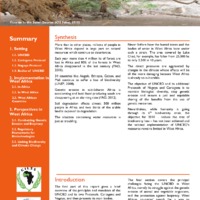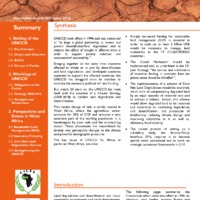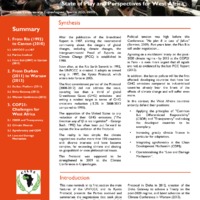Recherche
13 items
Characterizing and modeling the diversity of cropping situations under climatic constraints in west africa
The Sahel region is known for the high vulnerability of its agriculture to climate variability. Early warning systems that make use of agrometerological forecasts are one of the coping strategies developed by policy makers. However, the predictive quality of the tools and methods used needs improvement. In order to address some of these challenges, we conducted agronomic trials and on-farm surveys to adapt the SARRAH (Syst`eme d’Analyse R´egionale des Risques Agroclimatiques, version H) crop simulation model, and also evaluated it in farmers’ field conditions. The farmers’ practices such as sowing dates and densities, fertilizer use and yields potentials of the millet and sorghum crops were characterized under different climatic conditions.
Climate change impacts on water and agriculture in west africa
Climate change is going to affect all aspects of the water cycle. The quantity and distribution of precipitation, the frequencies and duration of droughts, as well as evaporation rates and the water balance at plot level will be impacted by climate change. The African monsoon, which regulates the lives of 300 million West Africans, is evolving: the monsoon’s year-to-year variability will increase, as will the occurrence of extreme rainfall. Agricultural activity will be more or less strongly affected by this change depending on the agro-ecological zone and particular economic activity. The main scientific studies concur: mean annual runoff and groundwater recharge will decrease and competition for water will be exacerbated by growing demand for water by other uses, such as hydro-electric generation. Studies conducted by the African Monsoon Multidisciplinary Analysis (AMMA) are clear in stating that the variability in precipitation both in space and in time will be a real constraint on farm production. Society will need to adapt. Yet we should not underestimate the complexity of any given approach; thus, irrigation schemes should be consulted and agreed upon by all downstream principals and water users involved, even from a neighbouring country. Many methods and their local variations exist to mitigate the vagaries of water availability. Most try to increase production while at the same time reducing dependence on, and vulnerability to, inputs and limiting their negative effects on the environment. Techniques include water saving methods and methods to conserve biomass and soil fertility.
Climate changes and food security impacts and vulnerability of rural and urban populations
The picture is bleak for food security in West Africa, due to the expected impacts of climate changes. Indeed, increased intensity of extreme weather events, droughts and water stress, warming of water and decreasing fish production, land degradation, changes in the distribution of animal and human vector-borne diseases, etc. are anticipated (IPCC, 2013). These effects are aggravated by a significant degradation of land and natural resources by human activities. Despite a possible increase in precipitation in some areas, West Africa is in a delicate situation because of its environmental, economic, and political vulnerabilities. Among others, key vulnerabilities are dependence on agriculture, low incomes, and the already significant variability in climate. Crops in West Africa are already affected by drought and depletion of water resources. Pests and diseases are common, and livestock is affected by regular outbreaks. Pastures rarely produce enough forage. People are dependent on markets and thus undergo changes in local and global food prices. The diet of the population is generally poor in animal proteins, sometimes in vegetables. According farming systems, specificities emerge in terms of vulnerability, such as: • Risks of significant flooding in irrigated farming system; • Low adaptation investments in farming systems based on tubers and cereals; • Isolation, high land degradation, and silting up of ponds in agro-pastoral farming systems based on millet and sorghum; • Drying up of water sources, bush fires, conflicts, and adverse terms of trade for cattle ranchers in pastoral farming system; • Shortages of drinking water in urban and peri-urban areas. Successful adaptation practices do exist. Some of them are presented in another note
Climate changes causes, manifestations, and effects in sahel
Published late 2013, the latest IPCC report demonstrates that the link between human activities and increasing temperatures observed since 1950 is very likely. These activities are manifested by massive emissions of Greenhouse Gases (GHGs) in the atmosphere, including carbon dioxide (CO2), methane (CH4), and nitrous oxide (N2O). Responsibilities are shared unequally between countries, but effects apply to everyone, especially African countries, particularly subSaharan ones. Yet, the African continent as a whole represents only 3.4& of global GHGs emissions and the CILSS/ECOWAS countries all together less than 1& of global emissions. At the global level, since the early 20th century, the temperature of the surface of the earth has increased by 0.8°C and sea levels rose from 19 cm. Each of the last three decades has been successively warmer than all previous decades since 1850! At the level of sub-Saharan Africa, climate changes are also important and disrupt farming activities, backbone of the economy: increase in the frequency of hot days and nights, heat waves, rainfall anomalies (annual and monthly volumes, heavy rains, consecutive dry days, start and end of the rainy season, etc.), increase in extreme weather events, etc. The example of the rainfall is striking: after experiencing an unprecedented drought in the world since the 1970s, West Africa has benefited from increased rainfall since the beginning of the 1990s, but with a strong interannual variability and more frequent episodes of heavy rains. The duration of the rainy season has decreased, while the frequency of flooding has increased. The impacts of climate changes are perceived by the West African populations, but their causes are not well understood. Informing these populations on climate changes, which will grow worse, is therefore an urgent challenge.
Desertification and climate change institutional responses and regional actions
The struggle against desertification and the protection of their natural resources has been a recurring theme since the 1970s in the policy documents of the West African States marked by the droughts of the Sahel. More recently, issues related to adaptation to climate change and its corollaries, how to adapt agriculture and maintain food security, have begun to be discussed even at the subregional level. Thus, many political and/or economic regional groupings of countries have defined strategic programmes or adopted legal instruments that allow them to integrate environmental questions into their action plans. It is not always easy to navigate the various programs and legal instruments. The regional and sub-regional institutions are many and often overlap thematically or geographically. Introduction The first section of this review presents policies and strategies on the environment and agriculture implemented on the African continent and in West Africa by a variety of institutions: the African Union (AU), the African Ministerial Conference on the Environment (AMCEN), the Economic Community of West African States (ECOWAS), the West African Economic and Monetary Union (UEMOA), and the Permanent Interstates Committee for Drought Control in the Sahel (CILSS). However difficult it may be to understand and to coordinate between these regional and sub-regional programmes, their very proliferation affirms the growing importance that the environment and its interdisciplinary nature has come to occupy since the Millenium Summit in 2000, where it was treated in isolation as one of the eight Millenium Development Goals (MDG). However, going beyond mere words, regional and sub-regional institutions, as well as the Member States themselves, have already taken action and have since the early 2000s begun to implement huge field actions involving efforts against desertification and land degradation, sustainable land and water use, reforestation, etc. We present only three field actions in this review but the list is much longer. This clearly demonstrates how the environment has become a cornerstone of sustainable development and a major concern of West African countries
Hydrological modeling of the bani basin in west africa
De nombreux bassins de drainage à travers le monde ne disposent d’aucune mesure de débit. Les méthodes de régionalisation sont alors généralement utilisées pour les prévisions en bassins non jaugés. L'objectif principal de cette étude est de prévoir les hydrogrammes d’écoulement dans le bassin du Bani afin de contribuer à l’amélioration de la connaissance sur la disponibilité des ressources en eau. Tout d'abord, le modèle hydrologique SWAT a été calibré sur de nombreux bassins jaugés sur la période de 1983-1992 et validé sur la période 1993-1997 en utilisant la méthode « Generalized Likelihood Uncertainty Estimation (GLUE) ». Ensuite, des groupes de bassins similaires ont été déterminés en fonction de leurs caractéristiques physiographiques et climatiques et au moyen d’une analyse statistique multivariée. Deux méthodes de régionalisation basées sur le concept de similarité entre bassins, ont été utilisées : la similarité physique et la proximité spatiale. Dans les deux cas, le jeu de paramètres calés du modèle est entièrement transféré du bassin jaugé vers le bassin non jaugé pour y simuler l’hydrogramme de débits journaliers de la période 1983-1997. Les résultats indiquent une bonne performance du modèle à l’échelle journalière et mensuelle, ainsi qu’à l’échelle du bassin et des sous-basins. La performance du modèle à l’échelle du bassin global et sur un pas de temps journalier est caractérisée par un critère de Nash de 0.76 et 0.84 et un coefficient de détermination de R2 de 0.79 et 0.87 en période de calibration et de validation, respectivement. Aussi, les valeurs absolues du PBIAIS demeurent inferieures à 25&, ce qui témoigne d’une bonne prévision du bilan d’eau. Il est à noter que les incertitudes associées demeurent satisfaisantes malgré les conditions de données limitées qui sous-tendent cette modélisation. Ainsi, 61& des débits observés (P-factor = 0.61) sont compris à l’intérieur de la bande d’incertitude dont la largeur reste adéquate (R-factor = 0.91). La calibration mensuelle a quant à elle permit d’atteindre une meilleure performance du modèle et une diminution des incertitudes à l’exception du bilan d’eau dont les erreurs de prévision semblent avoir augmenté. La calibration a également permis d'identifier 12 paramètres du modèle qui simulent au mieux les débits observés. Les bassins étudiés ont été classes en trois groupes: un groupe de bassins de plaine, semi-arides et situés au Nord, un autre groupe de bassins d’altitude qu’on rencontre dans les zones humides du Sud, et un troisième groupe situé dans le centre du bassin d'étude, à l'intérieur duquel, aucun des descripteurs semble se démarquer significativement des autres. Dans l'ensemble, la régionalisation a donné de bons résultats au niveau de plusieurs bassins cibles. Les meilleurs ont toutefois été enregistrés dans la zone aride et à l’exutoire global du bassin, particulièrement. Cependant, on note également une augmentation des incertitudes précisément dans cette zone. Une bonne similarité hydrologique mutuelle a été mise en évidence entre certains bassins, dont le meilleur indicateur reste la proximité spatiale. La connaissance de la disponibilité des ressources en eaux, particulièrement au niveau des bassins non jauges, est d’une utilité capitale dans plusieurs domaines d’application telles que l'allocation de l'eau pour la consommation et pour l'irrigation surtout en Afrique de l'Ouest qui fait face fréquemment à la gestion des risques liés au déficit en eau et a l'insécurité alimentaire en raison des impacts du changement climatique. Ces résultats contribuent également à une meilleure compréhension du fonctionnement hydrologique d’une zone jusque-là non explorée dans le domaine de la prévision en bassins non jaugés (PUB), et constituent une première étape vers de nouvelles investigations qui contribueront à l’amélioration des prévisions de l’information hydrologique.
Identification and Analysis of Areas at Risk and Populations Affected by Food and Nutrition Insecurity in the Sahel and West Africa
Facing recurrent food and nutrition insecurity affecting Sahelian and West African populations, governments and their development partners have set up mechanisms to monitor food situation. However, these mechanisms do not use the same methodological approaches, which often lead to results that are difficult to compare and which at times are even contradictory. Aware of this situation and the need to find a suitable solution, CILSS member states and partners have initiated the development of a Cadre harmonisé d’identification et d’analyse des zones à risque et des populations en insécurité alimentaire et nutritionnelle au Sahel et en Afrique de l’Ouest (Harmonized Framework for Identification and Analysis of Areas at Risk of and Populations Affected by Food and Nutrition Insecurity in the Sahel and West Africa). This tool, known as “Cadre Harmonisé” (CH), is expected to serve as a framework for countries to assess food and nutrition insecurity on an objective and consensual basis. The purpose of the Cadre Harmonisé is to help countries prevent food crises better and, where appropriate, quickly identify affected populations and appropriate measures to improve their food and nutrition security. The related method has been developed by a group of food and nutrition security experts from CILSS, FAO, WFP, FEWS NET, AFD, IPC/GSU, JRC/EC and UNICEF, and from international NGOs Oxfam International, Save the Children and ACF1. It is worth recalling that starting from 2008, various meetings held by the CH Technical Committee agreed for the CH to include some elements of the Integrated Food Security Phase classification version 1 (IPC 1.0). The IPC is a set of tools and procedures for classifying food and nutrition insecurity severity for decision making. Since the development of a manual for IPC 2.0, discussions have been under way to bring the CH closer to the IPC to incorporate lessons learned that improve comparability of results from the two tools. Similar to the IPC, the Cadre Harmonisé seeks to make best use of a set of tools and procedures for classifying the nature and severity of current and projected food and nutrition insecurity situations on the basis of a consensual analytical framework and classification scale. The CH is based on the following four conceptual models commonly used by national, regional and global mechanisms: Risk = f (Hazard, Vulnerability) Sustainable Livelihoods Framework The UNICEF Nutrition Conceptual Framework The four dimensions of food security (availability, access, utilization, and stability) The CH therefore is an integrated analytical framework built on a technical consensus that seeks to make best use of data from all systems or methods, namely food consumption surveys, nutrition surveys, the Household Economy Approach (HEA) or other information provided by agricultural surveys and market monitoring. The CH assesses food and nutrition insecurity, based on convergence of evidence from several indicators. The CH uses a food insecurity severity scale with five phases. Such a severity scale, which is an international one, makes it possible to make comparisons between countries of the sub-region and also at global level. CILSS was mandated to develop and implement the CH as a common tool for Sahelian and West African countries. Its analysis cycles will from now on help develop regional mapping of current food and nutrition situations and analyze projected situations. 1 Other institutions such as MIFRAC, IBIMET and CARE International initially contributed to the development of the present analytical framework. Cadre Harmonisé MANUAL Version 1.0 Page | 13 The CH also seeks to strengthen the regional integration framework in the CILSS-ECOWAS-UEMOA region so that collaborative and harmonized analyses of food and nutrition situations are conducted through the best possible use of other tools and analysis methods developed by national mechanisms and partners. Given the importance of the process of harmonizing the analytical framework for food and nutrition situations in West Africa, it is necessary that all food and nutrition security stakeholders take ownership of it and make it their decision-making tool. Furthermore, efforts are needed to strengthen the partnership framework within countries and to support the operations of early warning systems in order to improve the collection of reliable data. CH implementation relies on existing data collection mechanisms. Efforts should be made by countries and partners to provide financial support to these mechanisms - as CH implementation will from now on be the baseline reference for activating regional food reserves and mobilizing technical and financial partners (TFPs).
Multi-site validation of the swat model on the bani catchment: model performance and predictive uncertainty
The objective of this study was to assess the performance and predictive uncertainty of the Soil and Water Assessment Tool (SWAT) model on the Bani River Basin, at catchment and subcatchment levels. The SWAT model was calibrated using the Generalized Likelihood Uncertainty Estimation (GLUE) approach. Potential Evapotranspiration (PET) and biomass were considered in theverificationofmodeloutputsaccuracy. GlobalSensitivityAnalysis(GSA)wasusedforidentifying important model parameters. Results indicated a good performance of the global model at daily as well as monthly time steps with adequate predictive uncertainty. PET was found to be overestimated but biomass was better predicted in agricultural land and forest. Surface runoff represents the dominant process on streamflow generation in that region. Individual calibration at subcatchment scale yielded better performance than when the global parameter sets were applied. These results are very useful and provide a support to further studies on regionalization to make prediction in ungauged basins.
United nations convention on biological diversity (uncbd) state of play and perspectives for west africa
More than in other places, millions of people in West Africa depend in large part on natural resources which continue to deteriorate. Each year more than 4 million ha of forest are lost in Africa and 80& of the forests in West Africa disappeared in the last century (FAO, 2010). 34 countries like Angola, Ethiopia, Gabon, and Mali continue to suffer a loss of biodiversity (UNEP, 2008). Genetic erosion in sub-Saharan Africa is accelerating and local food-producing seeds are disappearing at an alarming rate (FAO, 2012). Soil degradation affects almost 500 million people in Africa and two thirds of the arable land is exposed to degradation. The situation concerning water resources is just as troubling. Introduction The first part of this report gives a brief overview of the principles and mandates of the UNCBD and its two Protocols, Cartagena and Nagoya, and then presents its main bodies. The second section introduces how far the UNCBD has been implemented and discusses specific aspects of agrodiversity and bio-security in the African context, then at the sub-regional West African level, and finally at the level of the individual countries of West Africa. Never before have the humid zones and the bodies of water in West Africa been under such a strain. The area covered by Lake Chad, for example, has fallen from 25,000 ha to only 2,500 in 40 years. The direct pressures are aggravated by changes in the climate whose effects will be all the more damaging because West Africa is already so vulnerable. The objective of UNCBD and its additional Protocols of Nagoya and Cartagena is to maintain biological diversity, stop genetic erosion and ensure a just and equitable sharing of the benefits from the use of genetic resources. Nevertheless, while humanity is going through its 6th biodiversity crisis, the objective for 2010 – reduce the rate of biodiversity loss – has not been achieved and the national implementation of UNCBD’s measures remains limited in West Africa.
United nations convention to combat desertification (UNCCD) : State of play and perspectives for west africa
UNCCD took effect in 1996 and was conceived of "to forge a global partnership to reverse and prevent desertification/land degradation and to mitigate the effects of drought in affected areas in order to support poverty reduction and environmental sustainability." Bringing together at the same time countries affected in whole or in part by desertification and land degradation, and developed countries expected to support the affected countries, the UNCCD has struggled since its creation to mobilise the necessary political will and funding. But, nearly 20 years on, the UNCCD has reset itself with the adoption of a 10-year Strategy (2008-2018) to combat land degradation and desertification. This recent change of tack is sorely needed in West Africa, where the agricultural sector accounts for 35& of GDP and occupies a very extensive part of the working population. It is handicapped by poor soils and the encroaching desert. These phenomena are exacerbated by already very perceptible changes to the climate and powerful demographic pressures. The key issues of UNCCD for Africa, in particular West Africa, are clear: Introduction Land degradation and desertification are major constraints to economic and social development. Inspired by that realisation, African, Latin American, and Mediterranean leaders called into being the UN Convention to Combat Desertification (UNCCD). Translation: Peter Gaechter, SOS Sahel Sharply increased funding for sustainable land management (SLM) is essential in order to scale up: at least 2 billion US$ would be necessary to manage land sustainably in the 17 CILSS/CEDEAO countries ; The Global Mechanism should be implemented and, as underlined in the 10year Strategy, “the sources and mechanisms of innovative funding, in particular from the private sector should be identified ”; The implementation of a scheme of Zero Net Land Degradation should be explored, which aims at compensating degraded land by an equal quantity of restored land and to achieve a balance. Indeed, this scheme would allow degraded land to be restored and contribute to combating degradation and desertification, the protection of biodiversity, reducing climate change, and improving adaptation to it, as well as, obviously, food security; The recent process of setting up a subsidiary body, the Science-Policy Interface (SPI), requires it to become quickly more operational and to work on strategic investment frameworks in SLM.
United nations framework convention on climate change (unfccc) state of play and perspectives for west africa
After the publication of the Brundtland Report in 1987, alerting the international community about the dangers of global changes, including climate changes, the Intergovernmental Panel of Experts on Climate Change (IPCC) is established in 1988. Soon after, at the Rio Earth Summit in 1992, the UNFCCC is created. It adopts an armed wing in 1997, the Kyoto Protocol, which enters into force in 2005. The first commitment period of the Protocol (2008-2012) did not address the issue, covering less than a third of global Greenhouse Gases (GHG) emissions and setting a modest target in terms of GHG emissions reduction (-5.2& in 2008-2012 compared to 1990). The opposition of the United States to any reduction of their GHG emissions ("The American way of life is not negotiable!" - George Bush, 1992) has often been put forward to explain the low ambition of the Protocol. The reality is less simple: the climate negotiations involve more than 190 countries with diverse interests and have become complex, far exceeding climate and abuting on geopolitical or even philosophical issues. This Protocol was supposed to be strengthened in 2009 at the Climate Conference in Copenhagen. Political tension was high before this Conference: "No plan B in case of failure" (Barroso, 2009). Five years later, the Plan B is still under negotiation... Agreeing on a multilateral treaty on the post2020 climate regime - by 2015 at the COP21 in Paris - is even more urgent that all signals are red, as evidenced by the last IPCC Report (2013). In addition, the last to pollute will be the first affected: developing countries that have low GHG emissions compared to industrialised countries already bear the brunt of the effects of climate change and will suffer even more. In this context, the West African countries ardently defend their positions: • Applying the principles of "Common But Differentiated Responsibility" (CBDR) and "Transparency" and asking the developed countries to be exemplary; • Increasing greatly climate finance in particular for adaptation; • Integrating agroforestry in the Clean Development Mechanism (CDM); • Operationalising the “Loss and Damage Mechanism”.
